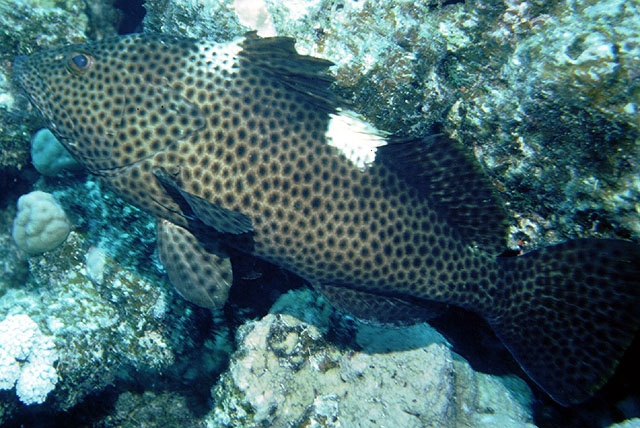| Epinephelidae (Groupers) |
| 60.5 cm TL (male/unsexed) |
|
reef-associated; marine; depth range 2 - 100 m |
| Pacific Ocean: Cocos-Keeling Islands to Samoa, north to southern Japan, south to southeastern Australia and Lord Howe Island (Ref. 37816). |
|
Dorsal spines (total): 11-11; Dorsal soft rays (total): 15-17; Anal spines: 3-3; Anal soft rays: 8-8. Brown spots evenly distributed and packed into hexagonal shapes only on adults which are generally larger (>25 to 45 cm); front portion of spinous dorsal fin about 50% taller than on other species at all sizes (Ref. 37816); small juveniles black with white blotches, becoming more spotted with age (Ref. 48635); further characterized by having ctenoid scales on body; auxiliary scales on body; greatest depth of body 2.7-3.1 in SL; rounded caudal fin; pelvic fins 1.7-2.0 in head length (Ref. 90102); head length 2.4-2.6 times in SL; flat to slightly convex interorbital area, convex dorsal head profile; preopercle with shallow indentation just above the enlarged serrae at angle; straight or slightly convex upper edge of operculum, posterior and anterior nostrils subequal; maxilla reaches to or past vertical at rear edge of eye, ventral edge with blunt hook-like process distally in fish larger than 35 cm SL; 2 rows of teeth on midlateral part of lower jaw (Ref. 89707). |
| Juveniles are found in shallow coral rubble, adults in isolated coral heads of lagoon and seaward reefs to depths of 82 m. Feeds mainly on sand-dwelling fishes and crustaceans, sometimes on octopuses. In the Hong Kong live fish markets (Ref. 27253). May be ciguatoxic in certain areas (Ref. 37816). Solitary, often seen on open sand and base of reefs (Ref 90102). |
|
Least Concern (LC); Date assessed: 24 January 2017 Ref. (130435)
|
| reports of ciguatera poisoning |
Source and more info: www.fishbase.org. For personal, classroom, and other internal use only. Not for publication.

